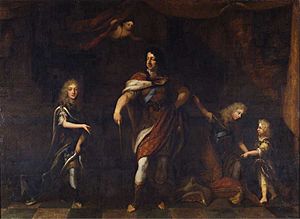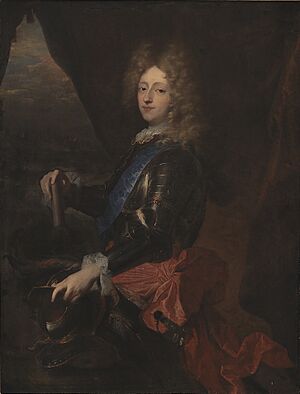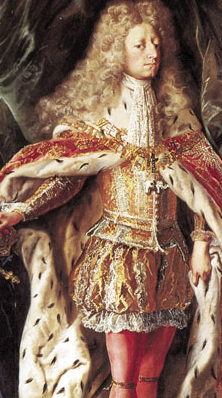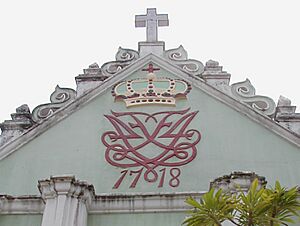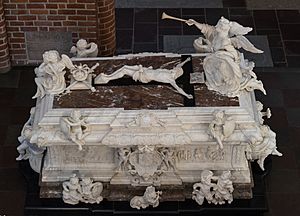Frederick IV of Denmark facts for kids
Quick facts for kids Frederick IV |
|
|---|---|
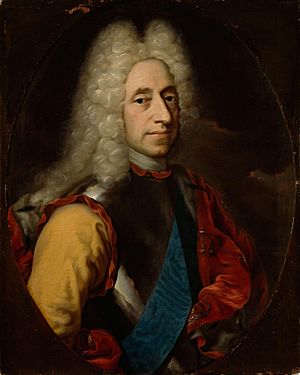
Portrait by Balthasar Denner
|
|
| King of Denmark and Norway (more...) | |
| Reign | 25 August 1699 – 12 October 1730 |
| Coronation | 15 April 1700 Frederiksborg Palace Chapel |
| Predecessor | Christian V |
| Successor | Christian VI |
| Grand Chancellors |
See list
Conrad von Reventlow
Christian Christophersen Sehested Ulrik Adolf Holstein |
| Born | 11 October 1671 Copenhagen Castle, Copenhagen, Denmark |
| Died | 12 October 1730 (aged 59) Odense Palace, Odense, Denmark |
| Burial | Roskilde Cathedral |
| Spouse | Louise of Mecklenburg-Güstrow Elisabeth Helene von Vieregg Anne Sophie Reventlow |
| Issue | Christian VI of Denmark Princess Charlotte Amalie |
| House | Oldenburg |
| Father | Christian V of Denmark |
| Mother | Charlotte Amalie of Hesse-Kassel |
| Religion | Lutheran |
| Signature |  |
Frederick IV (Danish: Frederik; 11 October 1671 – 12 October 1730) was the King of Denmark and Norway from 1699 until his death. He was the son of King Christian V and his wife Charlotte Amalie of Hesse-Kassel.
Frederick IV was known for his efforts to improve life for ordinary people in Denmark. He also led his country through a major war and built beautiful palaces.
Contents
Becoming King: Frederick's Early Life
Frederick was born on 11 October 1671 at Copenhagen Castle. He was the oldest son of King Christian V and Queen Charlotte Amalie. From the moment he was born, he was the Crown Prince, meaning he would one day become king.
As a young prince, Frederick traveled around Europe. He was very impressed by the buildings he saw in Italy. When he returned, he asked his father if he could build a summer palace. This palace, Frederiksberg Palace, was finished in 1703.
In 1695, Frederick married Louise of Mecklenburg-Güstrow. She became his first queen. When his father, King Christian V, passed away on 25 August 1699, Frederick became the new King of Denmark and Norway. He and Queen Louise were crowned on 15 April 1700.
What Did King Frederick IV Do as King?
Improving Life for People
One of Frederick's most important actions was ending vornedskab in 1702. This was a system where peasants in Zealand were tied to the land, almost like serfdom. This change gave them more freedom.
However, later in 1733, a new law called stavnsbånd was introduced. This law made peasants stay in their home areas. This meant they were still under the control of local nobles and the army.
Culture and Disasters in Copenhagen
After the Great Northern War, Denmark saw a growth in trade and culture. The first Danish theater, Lille Grønnegade Theatre, opened. A famous writer named Ludvig Holberg began his career during this time. Frederick also started the College of Missions, which helped send missionaries like Hans Egede to Greenland.
During Frederick's rule, Copenhagen faced two big problems. In 1711, a terrible plague hit the city. Then, in October 1728, a huge fire destroyed much of the old capital. Many important things were lost in the fire, including the notes of astronomer Ole Rømer.
Building Palaces
Frederick loved Italian baroque style. He had two beautiful palaces built. Frederiksberg Palace was made larger and more grand, finished in 1709. He also built Fredensborg Palace. Both palaces are seen as symbols of the end of the Great Northern War.
A Royal Visit to Venice
Frederick IV made a famous visit to Venice in the winter of 1708–09. He stayed for nine weeks with a large group of people. He pretended to be a count to avoid all the formal royal rules.
During his visit, the King often went to operas and plays. He also bought many beautiful Venetian glass items. A special boat race, called a regatta, was held on the Grand Canal in his honor. That winter was so cold that the Venice lagoon froze over! People joked that the King of Denmark brought the cold weather with him.
Denmark's Role in Wars
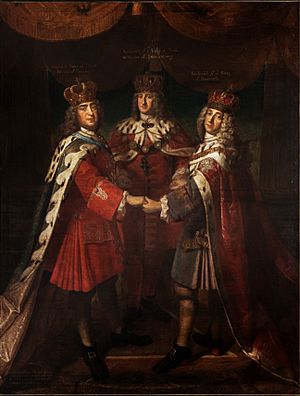
A big part of Frederick IV's rule was the Great Northern War (1700–1721) against Sweden. Denmark joined the war again in 1709 after Sweden lost a major battle. Frederick IV even led Danish troops in the Battle of Gadebusch in 1712.
Denmark-Norway ended up on the winning side of the war. An important result was that the Duchy of Holstein-Gottorp, which had been friendly with Sweden, was weakened. This helped Denmark become stronger in Schleswig-Holstein.
Frederick IV's Personal Life
Frederick was seen as a hardworking and responsible king. He was interested in art and architecture. He had several wives and partners during his life.
His first wife was Queen Louise of Mecklenburg-Güstrow. After her death, he married Countess Anne Sophie Reventlow. She became his second queen.
Out of nine children born to Frederick from his different relationships, only two survived to adulthood. These were Christian VI, who would become the next king, and Princess Charlotte Amalie. Both were children from his first marriage to Queen Louise.
Later Years and Death
In his later years, King Frederick IV became ill. He also had sadness in his private life, which made him more interested in a religious movement called Pietism. This faith became very important during his son's rule.
Frederick IV passed away in Odense on 12 October 1730, the day after his 59th birthday. He was buried in Roskilde Cathedral, where many Danish kings and queens are laid to rest.
Children of Frederick IV
With his first queen, Duchess Louise of Mecklenburg-Güstrow:
- Prince Christian (1697–1698)
- King Christian VI of Denmark (1699–1746)
- Prince Frederik Charles (1701–1702)
- Prince George (1703–1704)
- Princess Charlotte Amalie (1706–1782)
With Elisabeth Helene von Vieregg:
- Frederik Gyldenløve (1704–1705)
With his third wife and second queen, Countess Anne Sophie von Reventlow:
- Princess Christiana Amalia (1723–1724)
- Prince Frederik Christian (1726–1727)
- Prince Charles (1728–1729)
See also
 In Spanish: Federico IV de Dinamarca para niños
In Spanish: Federico IV de Dinamarca para niños


